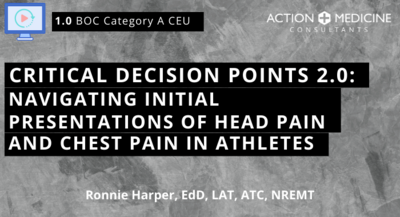Course Info (BOC Domains of Athletic Training; Presentation Description; Learning Objectives; Clinical Practice Gap Statement; Clinical Bottom Line)
BOC Domains of Athletic Training:
- Domain II - Assessment, Evaluation and Diagnosis
- Domain III - Critical Incident Management
- Domain IV - Therapeutic Intervention
Course Description:
This comprehensive course is designed for BOC Athletic Trainers, focusing on the evaluation and management of athletes experiencing head and chest pain. Through interactive case studies and scenario-based learning, attendees will refine their skills in patient assessment, environmental safety analysis, and primary care techniques, with a particular emphasis on symptoms such as rapid breathing, headache, and nausea.
Learning Objectives:
- Learn to quickly assess the safety of the environment in an athletic setting and identify any immediate risks to the athlete and Athletic Trainer.
- Evaluate the sequence of steps to conduct an effective patient assessment on an athlete exhibiting symptoms like rapid breathing, headache, and nausea, focusing on airway, breathing, and circulation evaluation.
Clinical Practice Gap Statement:
There exists a notable gap in the current training of Athletic Trainers, particularly in the rapid and effective assessment of acute medical situations in athletes, such as head and chest pain. This gap highlights the need for enhanced training in initial patient assessment, encompassing environmental risk evaluation and immediate response strategies. Many Athletic Trainers encounter situations where rapid decision-making is crucial, yet there is a lack of comprehensive training that integrates environmental assessment with immediate care techniques. This course aims to bridge this gap by providing in-depth knowledge and hands-on experience in assessing and managing potential emergencies, thereby equipping Athletic Trainers with the necessary skills to respond confidently and competently in high-pressure situations.
Clinical Bottom Line Statement:
The successful management of emergent health issues in athletes, specifically concerning head and chest pain, relies heavily on an Athletic Trainer's ability to perform prompt and effective patient assessments and interventions. This course underscores the importance of a systematic approach to patient assessment, emphasizing the need for immediate environment evaluation, recognition of signs of distress, and implementation of appropriate emergency care protocols. By enhancing these critical skills, Athletic Trainers will be better prepared to provide optimal care, mitigate risks, and potentially save lives in emergency scenarios commonly encountered in athletic environments.


